Click on images to enlarge
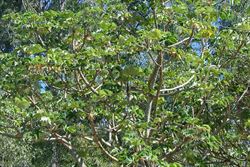
habit (Photo: Sheldon Navie)
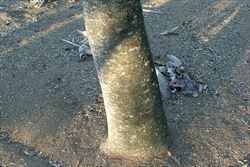
main trunk (Photo: Sheldon Navie)
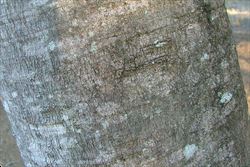
close-up of smooth bark on main trunk (Photo: Sheldon Navie)
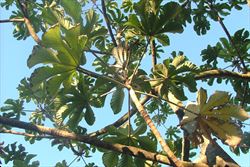
branches and large leaves borne on long stalks (Photo: Sheldon Navie)

large leaf with deeply-lobed margins (Photo: Sheldon Navie)
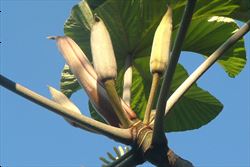
young flower clusters (Photo: Sheldon Navie)
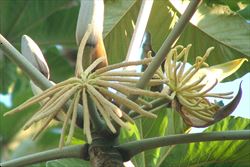
clusters of male flowers (Photo: Sheldon Navie)
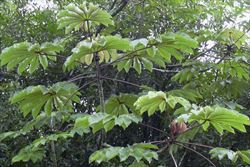
the leaves of Cecropia obtusifolia, a very similar species with lobes that are almost divided all the way to the leaf bases (Photo: Forest and Kim Starr, USGS)
Scientific Name
Cecropia Loefl. species: Cecropia peltata L.; Ceropia palmata Willd. and many others.
Family
Cecropiaceae
Common Names
Mexican bean tree, Cecropia, pop-a-gun, trumpet tree, trumpet-tree, snakewood, snakewood tree
Origin
Native to southern Mexico, Central America (i.e. Belize, Costa Rica, Guatemala, Honduras, Nicaragua and Panama), the Caribbean and tropical South America (i.e. French Guiana, Guyana, Surinam, Venezuela, Colombia and northern Brazil).
Naturalised Distribution
Cecropia peltata is naturalised in northern Queensland, in the wet tropics. Cecropia palmata ahs been cultivated in the same area.
Also naturalised in tropical Africa, tropical Asia, and on some Pacific islands (e.g. French Polynesia and Hawaii).
Habitat
Tropical and subtropical rainforest and disturbed sites. Shade tolerant.
Legislation
This species is declared under legislation in the following states and territories:
- Queensland: Class 1 - introduction into
the state is prohibited, and landowners must take reasonable steps to keep land
free of this species (throughout the entire state). It is also illegal to sell a
declared plant or its seed in this state.
Notes
Cecropia (Cecropia peltata) has occasionally been grown as a garden ornamental in northern Australia and has recently become locally naturalised in the Mission Beach-El Arish area in northern Queensland. This species is thought to have the potential to invade rainforest ecosystems in northern Queensland, possibly causing serious damage to our natural forests. Cecropia (Cecropia peltata) is a pioneer species in wetter tropical areas in its native range, commonly growing in canopy gaps in rainforests where it may become the dominant species. It is most likely to be found in similar habitats in northern Australia, as well as in riparian areas, disturbed sites and remnant patches of dry rainforest.
Overseas, cecropia (Cecropia peltata) is a very significant weed of forests in a number of other countries. Because of this, it has been listed in the Global Invasive Species Database, and is regarded to be among the top 100 of the world's worst invasive alien species. It is a particular problem because of its ability to quickly occupy gaps and form dense stands in natural vegetation, especially after natural or artificial disturbance events. It is thought to be replacing, or competing with, native pioneer species in some countries. For example, in Cameroon, cecropia (Cecropia peltata) has spread within large areas of disturbed vegetation along major roads where it is displacing a common native tree. It is also widely established in natural forests on some south Pacific islands (e.g. Tahiti and Raiatea).

